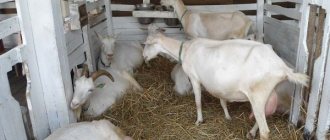February 16, 2019 Vladimir Khomyakov
Nothing will be lost
This article will be useful for rabbit breeders, as it provides another key to saving money on farms without much investment. It is proposed to fence off part of the rabbitry for keeping chickens. If you have chosen the outdoor shed method of raising rabbits, you will need to build a small chicken coop and provide the chickens with access to graze under the cages. Looking ahead, I will reveal the secret of the announced benefits. This is a saving on feed, due to the peculiarity of chickens to dig under the cages and finish up spilled feed after the rabbits. Even two or three good laying hens will delight you with a stable additional income in the form of homemade dietary eggs.
At one time I practiced such joint breeding and was pleasantly surprised by the effect obtained. Even without any special theoretical preparation, everything turned out well. True, then he changed direction and instead of birds settled goats in the vacated area. Circumstances were such that the need for healing milk, including for feeding mother rabbits and young rabbits, made appropriate adjustments. But that, as they say, is a completely different story. And recently, our regular participant, Andrey Kudakov from Troitsk, Chelyabinsk region, shared his positive experience on our forum. Therefore, I decided to touch more deeply on this topic, supplement my own observations and present the material in the form of a separate article.
Keeping chickens and rabbits together
In cases where it is not possible to keep rabbits and chickens separately, you should ensure the most comfortable conditions for each “neighbor”:
- allocate and fence off a separate area for eating. Rabbits should not have access to the bird feeder, and vice versa;
- take care of acceptable temperature conditions: eliminate the possibility of drafts, avoid overheating and excessive cooling of the enclosure;
- allocate an individual place for sleeping: rabbits must have their own closed corner for rest, and the bird must be sent to a special closed enclosure to roost at night;
- exclude the cohabitation of two male rabbits together: in this case, not only the chickens, but also the furry animals themselves will suffer and be bitten;
- There should be no more than a dozen chickens for every 2 rabbits - otherwise the rabbits will become irritable, lose sleep and appetite, and show aggression.
Video: keeping chickens and rabbits together
In any case, the cohabitation of rabbits and chickens will cause inconvenience: such a neighborhood will irritate the animals, frighten them and disrupt their natural behavior. It is best to keep these pets separately, and only in cases of extreme necessity, taking into account all the nuances and subtleties of keeping, can you combine the pastime of these animals. Did you know? The largest breed of chicken in the world is Brahma. The average weight of one laying hen of this breed reaches 5 kg, and the average egg production is about 250 eggs per year. The largest rooster in the world also belongs to this breed: its weight is 11 kg and its height is 91 cm at the withers. This giant lives in Somerset (UK) and is famous for single-handedly driving wild foxes away from his hen coop.
Try to create maximum comfort for the animals, taking into account all the recommendations given, you can provide your pet rabbits and birds with a completely tolerable coexistence
Rabbits and chickens - is it possible to keep them together?
It is possible to keep such diametrically opposed pets together in a dense habitat, but, as facts, experience and livestock analytics show, it is not recommended, due to the same difference in species.
There is a controversial opinion that chickens and rabbits do not have common diseases, so together they are not at risk of any infection. This is a misconception, let's look at why. Chickens can get salmonellosis, and rabbits and chickens often suffer from coccidiosis.
Rabbits and chickens - keeping them together poses a real risk that either the “fluffy” ones may become infected with various poultry diseases or vice versa, which will entail not only negative consequences for the health of the entire live population, but also, as a final result, the loss of a significant percentage of production.
And in general, the “eared” one does not feel confident and comfortable in the neighborhood of fussy and noisy laying hens.
Rabbits and chickens are kept together. Painting “Farmyard” by British animal artist Edgar Hunt.
What to do if “there are no options”
But still, if space allows, and the furry wards are provided with housing in separate cages, then placing them in the same pen with the chickens is acceptable. In this case, the owner will provide more thorough care to his charges, he will be able to provide timely veterinary care in case of illness.
We can give examples of a lot of other aspects that testify not in favor of the territorial coexistence of birds and rodents. If the family of a cabbage and carrot lover is kept in a cage, and his beak-headed neighbor is allowed free range indoors, then there is a great threat of aggression from the “feather bearers” towards young rabbits, which angry birds can peck through the net.
Final opinion
Rabbits and chickens - is it possible to keep them together? So, some farmers consider breeding furs along with poultry to be quite common, while others find this to be the wrong way to run a farming line.
Of course, there are many positive effects in joint maintenance, this is, first of all, a common premises and, as a consequence, restrained costs for depreciation of space and the overall planning of organizational factors. But this, as we found out, is where the list of optimization ends, which is confirmed by research by specialists in the industrial livestock sector of the national economy.
Rabbits and chickens kept together are completely different animals, which does not require special evidence. Moreover, growing both one and the other is a very troublesome task in itself, but the considered antagonisms also reinforce the idea that distance and isolation must still exist.
In order for the residents of the nursery to feel comfortable, and for the livestock breeder-naturalist to have insurance against unforeseen and absurd incidents, the surest choice would be to settle individuals of different species of living creatures in their own designated and specially equipped enclosures and premises.
Best wishes to you!
Breeding rabbits is quite a profitable business. Animals gain weight and reproduce very quickly. In order for this activity to give good results, it is necessary to become familiar with the peculiarities of keeping herbivores.
Quick search:
- The role of light in the formation of biorhythms.
- Lighting affects the growth of livestock numbers.
- How to determine the illumination of a rabbitry?
- Calculation of window opening sizes.
- Ultraviolet irradiation of rabbits.
- Infrared lamps in rabbit breeding.
- Go to comments.
Of course, rabbits in the wild, and even when kept in pits, spend a lot of time in holes where even a small ray of light does not penetrate. At the same time, the animals, moving in underground labyrinths, freely navigate them, build and then find their nests, give birth to cubs in them, which they then successfully nurse, dig new highways - communications and organize main and emergency exits to the surface. These facts mislead some rabbit breeders. They believe that their charges can be kept with little lighting and even in pitch darkness. But it seems to me that most readers will not fully approve of such a postulate. After all, since a rabbit has eyes, does that mean they are needed for something? Unlike the same moles, long-eared ones spend quite a lot of time on the surface, where they feed, drink water, mate, fight with each other, notice enemies and then run away and hide from them. Agree that without light these actions will be very difficult, since significant information about the world around us comes through the organs of vision. And even though rabbits do not see as well and clearly as you and I, the combined information according to the smell-image-sound scheme allows them to interact perfectly with the surrounding realities. This last remark applies one hundred percent to our pets. But light is needed not only for vision, or more precisely, for viewing.
RABBITIES DO NOT APPEAR TO bask in the sun and swim in the healing rays of the sun. Here they combine business with pleasure. This does not mean, however, that you need to keep them in direct sunlight all the time. If they do not overheat and do not get sunstroke, eye disease will easily develop, which can lead to complete blindness. If necessary, be sure to shade the cages with temporary screens.
We’ll talk about the benefits of sunbathing and ultraviolet radiation levels below. In addition, one cannot underestimate the influence of changes in light intensity during the day and even throughout the year on the formation of biorhythms, and therefore all vital functions of the body. In general, ignoring the role of light in a rabbit's life can have dire consequences. A lot of problems arise when would-be rabbit breeders begin to build their farms in closed rooms without windows or keep rabbits in cellars, limiting themselves only to ventilation openings. Yes, rabbits will not die immediately. For some time you will not notice any deviations in the life of the animals at all, but over time there will be more and more disturbances, and their consequences will become sadder and sadder. A long stay in darkness will almost certainly lead to infertility and will certainly lower general immunity, putting animals on the brink of survival. To put it simply, the rabbits will wither away. They will last a little longer if there is lighting, but it will be very weak. Those who take care of adequate lighting of places where animals are kept in a natural and, if necessary, artificial way, act very correctly.
Keeping chickens and rabbits together
In cases where it is not possible to keep rabbits and chickens separately, you should ensure the most comfortable conditions for each “neighbor”:
- allocate and fence off a separate area for eating. Rabbits should not have access to the bird feeder, and vice versa;
- take care of acceptable temperature conditions: eliminate the possibility of drafts, avoid overheating and excessive cooling of the enclosure;
- allocate an individual place for sleeping: rabbits must have their own closed corner for rest, and the bird must be sent to a special closed enclosure to roost at night;
- exclude the cohabitation of two male rabbits together: in this case, not only the chickens, but also the furry animals themselves will suffer and be bitten;
- There should be no more than a dozen chickens for every 2 rabbits - otherwise the rabbits will become irritable, lose sleep and appetite, and show aggression.
Video: keeping chickens and rabbits together
In any case, the cohabitation of rabbits and chickens will cause inconvenience: such a neighborhood will irritate the animals, frighten them and disrupt their natural behavior. It is best to keep these pets separately, and only in cases of extreme necessity, taking into account all the nuances and subtleties of keeping, can you combine the pastime of these animals.
Try to create maximum comfort for the animals, taking into account all the recommendations given, you can provide your pet rabbits and birds with a completely tolerable coexistence. / 13 Jan 2017 at 09:52
/ 13 Jan 2022 at 09:52
Dear readers, today’s article will be unusual. Rabbits and chickens can live in the same room; how can rabbits and chickens be kept together? In our thematic reviews, we often focus on breeding and caring for birds.
Giving preference specifically to chickens, but this time there will be no prerogatives as such - we will combine a number of certain understandings about livestock and poultry farming in one perimeter. Photos and videos are attached
"Dorm": part one
When maintaining a backyard nursery, the question often arises: “Is it advisable to keep animals of different species together?” In particular, is it possible to organize accommodation for feathered and furry pets in an undivided pen or enclosure?
Opinions differ here, but practice shows that, presumably, on eight to twelve acres of a backyard plot this is easily achievable
There is no categorical denial; it is important to comply with veterinary regulations and the requirements of the ecosystem of each species without violating biological boundaries
Chicken family
It’s as easy as shelling pears to get cockerels and cockerels, guided by the scale of the dacha plot. The bird tolerates a week-long absence of its owners - you can leave and come for the weekend, and twelve laying mothers will lay ten eggs a day.
The chicken’s diet is not meager, but also not ornate - it includes greens, boiled vegetables, grains, and water. Sometimes birds are fed with fish products, and meat bait is added to their food. Properly organized lighting and controlled daylight hours have a positive effect on egg production.
Competent actions in matters of veterinary care allow the winged family to be healthy and vigorous, and the offspring to inherit the best genetic qualities. To insulate chicken coops, the following are most often used: moss, sawdust, earth, straw, sand, and so on.
Rabbits are not only valuable fur
An apt word from the lips of satirists, in fact, emphasizes the comprehensive positive results from breeding “eared animals”. They bring practical benefits to their owners and are also relatively easy to care for.
Main rabbit food:
- Hay;
- Cabbage;
- Carrot;
- Cereals;
- Many other herbs;
- Dandelions – “leeward” leaves;
- Quench your thirst: water in summer, ice in winter.
Rabbits are kept (mainly in winter) by two or three individuals in a box. Although other options are possible. It is best to place a cage with a female with small cubs in a suitable barn or barn for this time, since the baby has a hard time withstanding frost, and the female rabbit spends a lot of energy feeding the babies.
When the time of birth is approaching, a warm medical heating pad is placed in the queen cell. When arranging boxes for the life of a fur-bearing animal, “deep bedding” is required (
5 cm) of hay or straw, it is very important to change it every five to seven days and monitor it so that mold does not form. Alternatively, a temporary continuous inset floor made of plywood, wood or lath is acceptable.
In severe frost they try not to change the litter
Alternatively, a temporary continuous inset floor made of plywood, wood or lath is acceptable. In severe frost they try not to change the litter.
Chickens - rabbits - coccidiosis.
But not everything is so smooth when rabbits and chickens live together. There is one very unpleasant thing called coccidiosis. For those who have forgotten what it is, let me briefly remind you. This is a disease caused by coccidia, single-celled parasites. They settle in colonies mainly in the liver of rabbits, less often in the intestines and form colonies (asexual reproduction) in the form of white inclusions the size of a millet grain or larger. With coccidiosis, rabbits swell, swear, stop growing, and often die when the form is advanced. Chickens can also become infected with coccidia. The greatest risk of death of chickens (up to six months) is from this scourge. Intestinal coccidiosis causes internal bleeding. Then traces of blood are clearly visible in the droppings. Adult chickens get sick less often, but once infected, they stop laying eggs or lay eggs outside the nests. They, however, like rabbits, always look disheveled.
There is an opinion among experts that different types of coccidia (there are more than 10 of them) parasitize a specific type of animal. I'm inclined to the same opinion. For example, people become infected with coccidiosis extremely rarely, only if they have problems with the immune system. But I never found a definite answer. They write that coccidiosis has not been sufficiently studied. Instead of experimenting, I use coccidiostatics. In any case, the load on the body increases when sexually mature oocysts enter it.
Why is a chicken-rabbit pairing so dangerous? It's all about the developmental characteristics of the parasite. The male and female cells fused together form an oocyst, which comes out with feces and then matures for a week to the invasive (infectious) stage. If the droppings are not removed within this period, then with the help of flies the developed oocysts end up on the feed and then into the womb of the rabbit. The cycle is completed. And flies are not necessary at all to infect chickens. They walk around and peck at everything themselves. If they come across a grain with a developed parasite, they will swallow it too. Then they themselves become carriers of coccidiosis.
In addition to preventing coccidiosis, Andrey also fights its carriers, flies. In certain periods there are especially many of them flying and then he uses the drug “Deltsid”. I, in turn, as an addition, can recommend adhesive tapes. They are very effective, at the same time they stick a lot of mosquitoes along with midges. And this means minimizing losses from myxomatosis, scratching, and itchy rashes. The result of the entire complex of work is the absence of coccidiosis in both rabbits and chickens throughout the entire time they were kept together in the same barn.
Insects are parasites.
We can absolutely say that all cutaneous insects coexist only on a certain type of animal. For example, chicken fleas and ticks will not be able to parasitize rabbits. However, this does not exclude general treatment of all inhabitants of the farm, since the treatment methods are completely the same.
Let me give you a specific example. You can often see chickens' paws cracked, sometimes bleeding. In rabbits, the most common problem is scabs in the ears. If both are generously lubricated with a mixture of kerosene and vegetable oil, the mites will die and the problem will quickly disappear. It’s better to do prevention periodically, once every two weeks. In case of severe infestation by insects (including fleas) and their rampant spread throughout the body, chickens and rabbits are prescribed universal Ivermec. This also saves time on treatment. Future laying hens need to have time to administer the drug two weeks before laying eggs.
Is it possible to keep rabbits and chickens in the same room?
Each owner has his own opinion about the proximity of birds and other animals. There are a lot of nuances in this matter. It is clear that a chicken and a rabbit cannot exist in the same cage. Housing them without partitions is dangerous for their furry inhabitants. Of course, no one can forbid you to keep them together. But such a risky step is fraught with loss of livestock, as well as constant diseases.
A barn is usually intended for one class of animals. This fact is caused by the requirements for living conditions, namely: insulation, feeding, walking. Chickens and rabbits do not live well in the same space. In farming there are such concepts as veterinary regulations and biological boundaries. Violation of these indicators guarantees failure in animal breeding.
The first reason against the neighborhood concerns common diseases. Both chicken and rabbit are susceptible to coccidiosis. If the infection affects one bird, there is a high probability of infecting all the inhabitants of the pen. A massive epidemic will require long-term complex treatment.
The second disadvantage of keeping them together is the gas pollution. Rabbits have an underdeveloped respiratory system. That is why it is recommended to keep them in an open space. Chicken waste products provoke an increase in the concentration of ammonia components in the air. For the eared, this is fraught with unpleasant consequences.
To house birds and furry ones together, you will have to equip a powerful ventilation system. From an economic point of view, this is unprofitable. Chickens and rabbits will feel uncomfortable in the same barn.
The above facts can be summarized with the following statement: if you do not have the opportunity to provide separate housing, then you should not cause inconvenience to yourself or the animals.
Real homemade eggs.
Anyone who has been involved in poultry farming for many years will definitely confirm that keeping chickens with an emphasis on grain is not profitable from an economic point of view. If you take nutritional value, usefulness, and, on the contrary, harmful inclusions into brackets, then store-bought eggs will leave no chance in competition. In other words, the grain will not pay for itself in the resulting product.
And this has always been the case, even in the prosperous 60s and 70s of the last century. Although a little yellow chicken cost only 5 kopecks, and for example, a kilogram loaf of white brick cost 22 kopecks (minuscule prices even at that time). Chickens on farms were not fed so many dubious feeds, synthetic food additives and growth hormones were not added, and they were not injected with so many chemicals. Although fish and fishmeal, used on some farms, changed the taste of eggs and chicken itself. Moreover, the fields were treated with dust, which practically did not decompose, accumulated in the grain and passed into the egg.
In our case, it opens up the possibility of feeding chickens using environmentally friendly waste from rabbit breeding. This means that the benefits of eggs increase, and their cost decreases sharply. Perhaps this is understandable, but I simply have to mention this key point.
Is it possible to keep chickens and rabbits in the same enclosure?
We answer one of the most controversial questions for many beginning farmers.
I have been keeping chickens for a long time and decided to expand the farm. I'm planning to get rabbits. My chickens live in a spacious enclosure, and that’s where I want to place the rabbits. I heard that this should not be done under any circumstances, because... chickens are carriers of the disease. Is it true? And is it still possible to keep and raise chickens and rabbits in the same room?
Good question, let's discuss!
Breeding domestic animals and poultry requires their placement in separate premises. This not only makes care easier, but also prevents the spread of diseases transmitted from one to another.
How much land do you need?
The second important question concerns the area allocated for such joint farming. It may seem that you will need to build something large and spacious. Not at all. Andrey fit everything in a solid slag-lit (cinder block) room with an area of 3x4 m and a height of 1.9 m. It seems quite small. I couldn't help but wonder about the availability of ventilation. After all, it is very important to adhere to sanitary standards so that both rabbits and chickens breathe clean air. Lack of oxygen can have a very detrimental effect on the growth, general condition of animals and even the taste of meat. In my case, for example, there was clearly more space. But practice has shown that air flow through a small window is sufficient. True, in the summer it’s a little stuffy in the barn. Therefore, you have to keep the door to the street open when it gets warm and until it freezes. In winter, the window is closed almost completely; if it gets warmer, it is opened slightly.
AND STILL , I advise you to build passive supply and exhaust natural ventilation in any household, even a small one. An ordinary pipe (preferably with a turbo deflector), extending outward above the top point of the roof by a meter to one and a half. Otherwise, there will be no traction and even a reverse cast is possible. It is important to position the pipe so that the main air flow passes away from the cages and perches.
Is it possible to keep rabbits and chickens in the same room?
If everyone is vaccinated, is it possible to keep chickens and rabbits in the same room?
You can’t keep chickens in the same barn with anyone! The chickens will pass fleas to the rabbits, and the rabbits will go bald.
Yes Yes. It's true about fleas.
What a horror, but at least the cows won’t go bald from the chickens? Do you mean fleas? Don’t fleas and louse live on skinny animals? How can you rid chickens of this nasty thing? I have brooms with wormwood hanging in my barnyard, the air is fresher and it seems to me that all these lice and fleas don’t really like this grass. And I understood everything about rabbits and chickens, thanks for the answer. The only thing that is not clear is that if chickens cannot be kept in the same room with anyone, then they will freeze alone. At least heat comes from the cattle, but the chickens themselves will not heat their coop with heat. Or am I not right?
It is possible to keep chickens and rabbits in the same room; they do not have common diseases. I have been keeping chickens and rabbits in the same room for many years; the chickens roam freely, even in the rabbits’ pen, and even lay eggs there.
Complete nonsense, of course you can! Experience over many years has shown that even in winter it is necessary, they generate more heat for each other and do not interfere with each other at all.
From the answers on the forum.
Breed "Speckled Dominant".
“How can I support it? No problem! I have a permanent shed. There are rabbits in cages, chickens on the floor. Rabbits are essentially very sloppy animals... Chickens as orderlies. I hardly give food, they pick up after the rabbits. They also lay eggs. I go in to feed him in the morning and evening. The silence is dead in the barn. As soon as you cough, the chickens shout: cocococo!... They cry for 5-7 seconds, then silence..."
From further correspondence it became clear that Andrei started rabbits relatively recently, 3 years ago. But I was involved in chickens long before that. He also has experience in breeding ducks, indo-ducks, and geese. That is, the process is the opposite of what was in my case, but this, as it turned out, does not change the matter. There is enough time for such joint maintenance, despite the fact that he works at the factory, and in his free time he manages to realize his hobbies of building choppers based on heavy motorcycles.
The first thing you will probably ask is, what is the population? Quite a lot. Half a hundred rabbits and a dozen egg-laying chickens fully provide the family with dietary meat and the same dietary eggs. There is still some left for sale. For narrow-profile rabbit breeders, I will explain that an egg remains dietary for 7 days from the date of laying. This means that the main food on the table will always be healthy and healthy, which is important in our time. I must say that broiler chickens get along quite well with rabbits, as was the case in my practice. Who likes what?
ANDREY BREEDS hens of the Hisex Brown breed (brown) and Gray-speckled dominants and rabbits of the giant breed "Flandres".
How can you increase the number of livestock by adjusting lighting?
Experienced rabbit breeders know that at different times of the year the probability of achieving an increase in the number of animals is different. Not least of all, this is due to the fact that animals seem to sense the approach of unfavorable conditions for reproduction and nursing of cubs, and wait for some time, going into a low-active phase. If we turn again to the wild rabbit, then it does not breed continuously throughout the year. Depending on climatic and weather conditions in different parts of the world, females give birth from 2 to 7 times. By conditions, I primarily mean ambient temperature, feed availability and daylight hours. What conclusion should we draw from this? That's right, we need to strive to artificially create conditions on the farm under which rabbits will not “doubt” that the born offspring will safely begin to gain condition, will not freeze, and will not die of hunger, first from a lack of milk, and then from ordinary feed. Today we won’t talk about food and temperatures. Enough has already been said about this. Let's talk more specifically about how the farm needs to be illuminated so that mating and mating are effective, false pregnancies no longer upset us, and the baby rabbits are born healthy. In other words, let's find out why, for example, in late autumn it is so difficult to achieve coverage, even by providing the rabbits' diet with vitamins, high-calorie feeds and even heating the room with them? A lot of research and experiments have been carried out on this topic, and there is also a wealth of experience in keeping animals on industrial farms. So it has been established that it is necessary to maintain a lighting schedule, and for various categories of animals the illumination should be optimal. For example, the intensity of light falling on a cage with a breeding male is not at all the same as for a child with fattening young animals. Next, I will give specific figures for the recommended illumination of cages for different categories of rabbits, expressed in Lux, and only then I will touch upon the technical measures for its implementation in a specific farm, a rabbitry. So, try to maintain the following illumination levels:
- Males of the main herd - from 100 to 125 Lx
- Females of the main herd - 50-70 Lx
- Fattening young animals - 10-25 Lx
Low illumination of 25 Lux does not allow young animals to be too active and waste energy on fights and unnecessary running around. And these 25 Lux are something like twilight; in such lighting you can’t even read. As for adult rabbits, maintaining these parameters in completely enclosed spaces is not easy, since you will need to take into account energy costs. Although energy-saving illuminators and diode lamps are now widely used, they are not cheap, and Chinese counterfeits often burn out during power surges. I repeat once again that lighting cages or enclosures around the clock makes no sense and is even harmful. But at the same time, you need to “hint” to the rabbits that the time of year is summer (or the location is the equator) and the sun is above the horizon, as it should be, for 12-16 hours. It is not necessary to go to the farm every time and flip the switch. It is enough to set a regular timer, which will do this work for you strictly at a certain time. Keep in mind that the length of daylight hours has a greater impact on the sexual activity of females than the intensity of light. Therefore, if circumstances force you to start saving, it is better to change the light bulbs to less powerful ones, but do not reduce the lighting time. Parameters such as sexual activity of females (acceptance of a male) and fertility are especially dependent on the length of daylight hours. For males, 8 hours of light would be enough, but in low light, less than 80 Lux, they become lethargic and practically do not react to the opposite sex.
The GENERAL ILLUMINATION in a room can be doubled with the same light sources by whitening the walls white and installing reflective screens in certain places. Considering that the average illumination is about 40-45 Lux and is not distributed evenly, place cages with males closest to the light source, and a little further away - with females. Young animals can generally be kept in cages located on the second line. Thus, simply redistributing cells will bring you additional profit. And often there is no need to move the cages; it is enough to relocate the animals accordingly.
The resulting noise is not scary.
From my own experience I know that rabbits do not really like extraneous noise. From a sudden strong sound they begin to go hysterical and have a fit. At best, they become stressed, which is still very bad. And in the worst case, the spine may break (complete or partial paralysis) or a limb may crack, or a joint may dislocate. These are all very real things. And if the chickens, as Andrey writes, cluck for several minutes, then the roosters can crow shrilly and suddenly. What to do then?
| Subscribe to our website's weekly newsletters: ✦ BROTHER RABBIT ✦ Current notes on keeping rabbits are waiting for you. SUBSCRIBE |
Andrey did it simply. He has no roosters. But I had one, and he was so vocal and at the same time cocky, he attacked suddenly and from behind. Sometimes we had to catch him throughout the building, not wanting to enter the fenced-off chicken coop. And the chickens themselves can make some noise. One is cackling, the rest are supporting. All this certainly has an effect on rabbits. However, not everything is so sad. I soon noticed that they quickly got used to it and became somehow indifferent to the cock and chicken performances. Why, we even got used to the barking of a dog tied nearby, although at first we were just as nervous. In general, there are no problems with this either.
It’s the same with Andrey: “Chickens cackle, but rabbits don’t listen. The dog barks and there is no reaction either. But they get very scared if, for example, I give them food, then I sit down, admire them and suddenly stand up without words. Or someone else enters the barn.” Just in case, maybe they sit on top of the cages and scare the long-eared ones? I remember that for some reason mine didn’t fly. He generally has two-tiered blocks of cells. He writes that they do not have enough strength to fly there and have no thoughts. And thanks to them for that. Enough work under the cages too.
Why can’t you climb into the nest of a female that has hatched and touch the baby rabbits?
This opinion is not always true. Inspection of the nest in the first days after birth should be carried out, but in such a way as to disturb the female rabbit less, and baby rabbits can only be touched with clean hands (without the smell of perfume, soap, tobacco). The rabbit is very sensitive to foreign odors. Annoyed by the inspection, she can injure her offspring. When inspecting the nest, stillborn, sick, and weak rabbits are removed, and the development of the female’s nipples and milk production are also determined.
To prevent the female from running around the cage and injuring the offspring when inspecting the nest, she is given tasty food or temporarily removed from the cage.
After inspecting the nest, the baby rabbits are covered with nesting fluff and after a while the female is brought in, stroking her with his hands. The rabbit gets used to the smell of hands and reacts more calmly to human actions.
If everything is normal and calm in the nest, then the nest is inspected visually.
Nutrition
How much can one chicken eat per year to lay eggs? 40 kg of feed and 15 kg of greens and hay. She should receive 320 kcal from food per day, including 20 g of protein.
Now let's multiply these numbers by fifty conventional chicken heads and get an impressive figure. I won’t talk about feed prices, so it’s clear that the costs will be significant.
What do they feed quails? My father makes a mixture of special feed, mineral supplements and fresh vegetables for them. In general, the consumption per day is small. As a basis, I will take 8 cages with birds, each of which contains an average of 25 quails.
In this situation, it turns out about 6 kg for all cells per day. In my opinion, this is quite a bit.
Let me remind you that ONE chicken eats 40 kg of dry food per year! What if there are fifty of them?
In addition to the mixed feed, the father feeds the birds with fresh grass, shell rock and eggshells. Yes, yes, waste-free production is achieved. Very comfortably.
"Dorm": part one
When maintaining a backyard nursery, the question often arises: “Is it advisable to keep animals of different species together?” In particular, is it possible to organize accommodation for feathered and furry pets in an undivided pen or enclosure?
Opinions differ here, but practice shows that, presumably, on eight to twelve acres of a backyard plot this is easily achievable
There is no categorical denial; it is important to comply with veterinary regulations and the requirements of the ecosystem of each species without violating biological boundaries
Chicken family
It’s as easy as shelling pears to get cockerels and cockerels, guided by the scale of the dacha plot. The bird tolerates a week-long absence of its owners - you can leave and come for the weekend, and twelve laying mothers will lay ten eggs a day.
The chicken’s diet is not meager, but also not ornate - it includes greens, boiled vegetables, grains, and water. Sometimes birds are fed with fish products, and meat bait is added to their food. Properly organized lighting and controlled daylight hours have a positive effect on egg production.
Competent actions in matters of veterinary care allow the winged family to be healthy and vigorous, and the offspring to inherit the best genetic qualities. To insulate chicken coops, the following are most often used: moss, sawdust, earth, straw, sand, and so on.
Rabbits are not only valuable fur
An apt word from the lips of satirists, in fact, emphasizes the comprehensive positive results from breeding “eared animals”. They bring practical benefits to their owners and are also relatively easy to care for.
Main rabbit food:
- Hay;
- Cabbage;
- Carrot;
- Cereals;
- Many other herbs;
- Dandelions – “leeward” leaves;
- Quench your thirst: water in summer, ice in winter.
Rabbits are kept (mainly in winter) by two or three individuals in a box. Although other options are possible. It is best to place a cage with a female with small cubs in a suitable barn or barn for this time, since the baby has a hard time withstanding frost, and the female rabbit spends a lot of energy feeding the babies.
When the time of birth is approaching, a warm medical heating pad is placed in the queen cell. When arranging boxes for the life of a fur-bearing animal, “deep bedding” is required (
5 cm) of hay or straw, it is very important to change it every five to seven days and monitor it so that mold does not form. Alternatively, a temporary continuous inset floor made of plywood, wood or lath is acceptable.
In severe frost they try not to change the litter
Alternatively, a temporary continuous inset floor made of plywood, wood or lath is acceptable. In severe frost they try not to change the litter.
Content Features
Of course, for the comfortable existence of domestic animals, it is desirable for each individual species to have its own territory - this helps to maintain a sense of security in the animals and their peace of mind.
demanding conditions of detention: it is important for them to have a large space for walking and good hygienic conditions, sensitivity to the cleanliness of the enclosure and air: they do not like dirt, and dust particles and an abundance of fluff in the air contribute to difficulty breathing,
the need for a special straw flooring that does not contain sharp stones or hard pieces of soil: the animals have quite delicate skin and are often injured by sharp objects, the need for a balanced diet: the basis of rabbit nutrition is specialized food, some fresh vegetables and fruits (carrots, beets, apples, etc.), maintaining the correct temperature regime: in extreme heat, the rabbit is at risk of overheating, which will cause serious illnesses. To avoid this, a special canopy is installed in the enclosure, which protects the long-eared animals from the scorching sun.
- undemanding to living conditions: the bird does not suffer in cramped spaces or without access to fresh air,
- insensitivity to the cleanliness of the poultry house: chickens feel good even in an uncleaned room,
- need for a balanced diet: the basis of nutrition for laying hens is hay and straw, grain, cooked cereals, some vegetables,
- need for small pebbles, dust and ash. Laying hens love to bathe in dry soil and ash - this saves them from parasites in their feathers, and small pebbles are necessary for laying hens to better digest food: birds swallow them, and the food, rubbing against stones in the stomach, is better absorbed,
- the need for a special fenced-off place intended for overnight stay.
Differences:
- Rabbits, by their nature, are quite peaceful creatures that do not show aggression and alternate active pastime with quiet rest in the shade. But the way of life of chickens is very active: they are constantly on the move, looking for food or simply taking walks in the sun.
- If chickens like to dig in the dust and do not feel constrained in conditions of limited movement, then for long-eared animals such an environment is accompanied by stress and even diseases.
Is it possible to keep rabbits and chickens in the same room?
In conditions of limited space, some farmers decide to keep different types of domestic animals together in one enclosure. This raises the question: can rabbits be kept together with chickens? Experts say it is possible, but not advisable. Such joint keeping has its own nuances related to the nature of animals:
Herbivores and chickens are very different animals with opposite personalities. If rabbits love peace and tranquility, then birds are very active, noisy and practically do not sit still. The diet of pets is very different: chicken food can cause fatal poisoning of a herbivore. Soured food and spoiled food are dangerous for furry animals. Boiled porridge is also a harmful product, as it leads to constipation and poisoning of eared animals. Animals should be fed separately. Safety
For the full development of poultry, the presence of hard stones in the barn is important, while in keeping rabbits it is important to avoid sharp objects that can harm pets. Some diseases can be transmitted from chickens to herbivores and vice versa. Differences in sanitary requirements and temperature conditions. Herbivores are very sensitive to overheating and drafts, while chickens feel comfortable in such conditions
Cold weather can be disastrous for poultry, but it is not scary for a rabbit.
Chickens and rabbits in the same room
Chickens and rabbits in the same room - advantages:
- reducing the cost of maintaining premises;
- One-time disinfection;
- cumulative vaccination planning.
If the farmer has no other choice than to keep the animals together, then it is necessary to first prepare comfortable living conditions for them.
- fence off the eating area; herbivores should not have access to bird food;
- regularly clean the contents of feeders;
- take care to maintain temperature conditions, get rid of drafts and protect from overheating;
- provide animals with individual sleeping areas;
- eliminate the possibility of keeping two rabbits in the same room to avoid fights.
Note! It is allowed to keep two rabbits with ten chickens. If there are more birds, the animals may have trouble sleeping, they will lose their appetite, become nervous, irritable and begin to show aggression
Rabbit cages can be kept in a barn with chickens; in winter it is recommended to take them outside. It is worth considering that keeping them together will cause inconvenience for both chickens and herbivores. The presence of neighbors will frighten, irritate and disrupt the natural behavior of animals. Female rabbits feeding young animals are very wary of birds. Experienced rabbit breeders talked about cases when birds attacked and pecked young animals. Also, long-eared animals do not feel well in a polluted room and can get sick due to lack of fresh air.
Keeping rabbits and chickens
Keeping rabbits is not difficult; even a novice breeder can figure it out on his own
It is important to properly arrange housing for your pet and ensure that sanitary and hygienic standards are not violated. In some villages, thanks to the insulation of the cages, rabbits are kept outside all year round.
In dacha conditions, raising herbivores together with poultry is allowed. However, the experience of specialists shows that this is additional stress and discomfort for animals, so it is better to keep pets separately.
Keeping chickens and rabbits together is a controversial issue that many farmers ask. On the one hand, this saves space, on the other hand, there is a possible risk of various troubles. You will learn in our article how to arrange cohabitation of chickens and rabbits and at the same time make it not only safe, but also profitable.
p, blockquote 1,0,0,0,0 —>
Conclusions.
In modern economic conditions, taking into account the constant rise in the cost of feed and energy costs for heating premises, keeping rabbits and chickens together will be one of the ways to optimize costs. So what do we gain?
- The time required to maintain the farm does not increase significantly, and profitability increases due to poultry products.
- The chickens carefully select all the food that spills under the cages and destroy the larvae of flies and other large insects.
- When chickens and rabbits live together in a room, more heat is generated, which allows you to save on artificial heating.
- Most concentrated feeds are universal and will suit both types of animals.
- Both chickens and rabbits tolerate long-term absence of owners (up to a week) in the presence of automatic feeders and drinkers.
- Prevention against coccidiosis and many other diseases that may appear on the farm can be carried out on chickens and rabbits at the same time.
- In addition to dietary meat, real homemade eggs, no less dietary, will appear on your table.
Please share this article with your friends on social networks:
Please rate the article. Ask a question, discuss on the forum.











